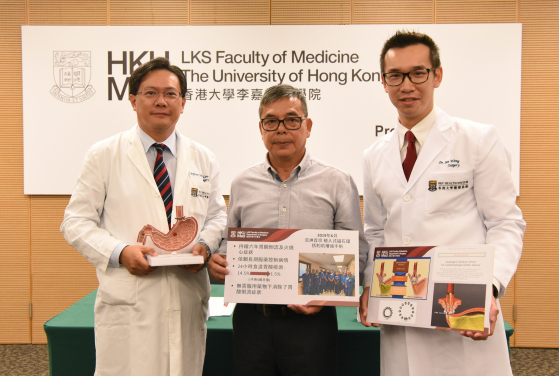Media
HKUMed successfully performed
Asia’s first magnetic sphincter augmentation
for gastroesophageal reflux disease
17 Dec 2019
LKS Faculty of Medicine, The University of Hong Kong (HKUMed) has successfully performed Asia’s first magnetic sphincter augmentation for gastroesophageal reflux disease (GERD). The surgery was led and carried out by the Division of Esophageal and Upper Gastrointestinal Surgery of the Faculty’s Department of Surgery.
A small, flexible ring of magnets was implanted around the lower esophagus using a minimally invasive keyhole surgical technique to restore the normal sphincter function. This novel device (the ring of magnets), which was approved by the US Food and Drug Administration (FDA), is specially designed to allow food to pass through the lower esophageal sphincter and at the same time prevent the gastric content to reflux back to the esophagus. The major advantage of this approach is to prevent alteration of the stomach anatomy and reduce the side effects of traditional anti-reflux procedure. The procedure (magnetic sphincter augmentation) provides an alternative for patients that are suffering from refractory GERD symptoms or complications.
Background
Gastroesophageal reflux disease (GERD) is traditionally a western disease. However, with the increase in incidence of obesity and adoption of western lifestyle, the incidence of GERD in Asia has also increased. A recent study by HKUMed showed the prevalence of GERD had increased by 1.3% between 2002 and 2011[1] ; and a further increase was noted in a recent update to around 4.5% of the general population. Majority of the GERD patients can be treated by medication. However for patients who do not prefer long-term medication or those with persistent symptoms/complications despite medication, surgery may be indicated. Laparoscopic fundoplication with hernia repair is the gold standard and time-proven procedure for more than 50 years. The major side effects of this procedure include dysphagia, gas bloating syndrome, failure to belch and recurrence of symptoms. It also requires the mobilisation of the top part of the stomach to wrap around the lower esophagus to restore the sphincter function. Many newer endoscopic procedures have been introduced, but the anti-reflux results are not comparable to this gold standard procedure.
Novel device ∙ Simple technique ∙ Quick recovery
This new procedure (magnetic sphincter augmentation) involves making five keyhole incisions over the upper abdomen. With the help of a high-definition laparoscopic camera inside the abdomen and simple laparoscopic instruments, the loosened muscle opening in the diaphragm is repaired. The size of the lower esophagus is measured by a special sizer. A ring of 13-17 titanium beads with magnetic core is implanted around the lower esophagus, leaving the top of the fundus untouched. The procedure is simple and usually required less than two hours to complete. The patient can resume eating immediately after operation and discharged from the hospital the following day. This procedure has been well studied in the Western countries with more than 30,000 magnetic rings implanted. The anti-reflux results are comparable to laparoscopic fundoplication. 85% of patients are free from long term anti-reflux medication after the procedure[2] . With this procedure, patients suffer from less bloating sensation and improved ability to belch, as compared to classic fundoplication. The documented rate of erosion (invasion into esophagus/stomach) was 0.15% and the incidence of explant (removal of device) by endoscopic/minimally invasive mean is around 2.7%[3] .
HKUMed is the first to introduce this procedure in Asia, followed by Singapore. To date, it is the only two centres in Asia that can perform this procedure. The first surgery was carried out in June 2019 on a 59-year-old gentleman. He and the subsequent few patients who underwent this procedure had all GERD-related symptoms resolved and remained drug free six months after the procedure with an improved quality of life. The most recent patient was admitted on the day of the surgery and was discharged home within 36 hours of admission. HKUMed is now organising the first Asia training workshop on magnetic sphincter augmentation in January 2020, hoping to share our experience and extend this technology to other centres in Asia.
About the surgical team
The surgery was led and carried out by Professor Simon Law Ying-kit and Dr Ian Wong Yu-hong, Division of Esophageal and Upper Gastrointestinal Surgery, Department of Surgery, HKUMed. Professor Simon Law Ying-kit is the Cheung Kung-Hai Professor in Gastrointestinal Surgery; Chair Professor and Chief of Division of Esophageal and Upper Gastrointestinal Surgery. Dr Ian Wong Yu-hong is Clinical Assistant Professor subspecialising in esophageal & upper gastrointestinal surgery.
Media enquiries
Please contact HKUMed by email ([email protected]).
Please visit the website at http://www.med.hku.hk/news/ for press photo and presentation slides.
[1] Tan VP, Wong BC, Wong WM, Leung WK, Tong D, Yuen MF, et al. Gastroesophageal Reflux Disease: Cross-Sectional Study Demonstrating Rising Prevalence in a Chinese Population. Journal of clinical gastroenterology. 2016;50(1):e1-7.
[2] Ganz RA, Edmundowicz SA, Taiganides PA, Lipham JC, Smith CD, DeVault KR, et al. Long-term Outcomes of Patients Receiving a Magnetic Sphincter Augmentation Device for Gastroesophageal Reflux. Clin Gastroenterol Hepatol. 2016;14(5):671-7.
[3] Smith CD, Ganz RA, Lipham JC, Bell RC, Rattner DW. Lower Esophageal Sphincter Augmentation for Gastroesophageal Reflux Disease: The Safety of a Modern Implant. J Laparoendosc Adv Surg Tech A. 2017;27(6):586-91.

